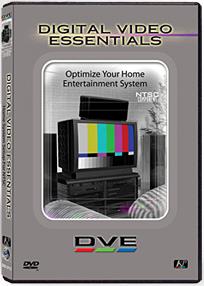|
||||||
|
Digital Video Essentials (DVE) is the latest installment from Joe Kane Productions for home theater calibration. This DVD supersedes Joe’s previous efforts (Video Essentials, and A Video Standard). The opening of DVE includes some shots of a launch of the Space Shuttle Atlantis mission STS-106, a mission to the International Space Station, from Pad 39B at Kennedy Space Center.
The smaller metal beams and braces show remarkable detail. However, there was a problem caused by the down-conversion possess which left all the video material and montage sequences with acute edge enhancement/ringing. This material is NOT an example of what to shoot for in NTSC DVD video quality. The photo below shows the ringing in the frame above, enlarged.
After the opening credits and the shuttle launch, DVE launches into an
approximately ten minute narrative on video quality and digital signal
processing to help educate users about digital video and DVE, and then a
short discussion of how its menu system works. DVE makes full use of the DVD menu system. You may have noticed on your DVD remote that there is a “Menu” button and a “Top Menu” or “DVD Menu” button. The DVD system defines two types of menus, and it is up to the DVD authors to decide how these menus work. Many DVDs either disable one of the menu buttons or make them both link to the same menu. DVE uses the “Top Menu” button as the overall program menu and the “Menu” button to show the menu for the individual chapter that you are currently in. Examples of the various menus are shown below.
Room Environment
This section of DVE covers both acoustic and visual room environment
properties. It goes into detail on how speaker and listener placement as
well as objects in the room and room construction can impact audio quality.
Similarly, DVE talks about how ambient light and colors impact picture
quality and how best to address these issues.
Here are the contents of the audio calibration section:
Here are the contents of the video calibration section:
DVE will help you calibrate your TV as well as can be done without
professional equipment and training. Solving certain problems in your TV,
like badly set grayscale is best left to a professional and is really worth
doing because it can dramatically improve the quality of your TV image. The DVE
website has details on helping you find a professional TV calibrator.
Finally, DVE includes a full range of audio and video test signals to help
you further adjust and dial in your system. The full chapter list, including
references to all of the test signals,
is here.
The initial promotional material stated that DVE would use a new process
called True Progressive Mastering. Simply stated, the normal DVD mastering
process converts the video signal to an interlaced signal (if the material
was progressive to begin with) before the MPEG encoding. As a part of the
interlacing process, a 30% vertical filter is
JKP has previously stated that both a Professional DVD release of DVE and a
Windows Media 9 release of DVE are in the works. The current indication is
that, if the WM9 discs are ready, they will be included in the Professional
release. The WM9 release will come in both 1024p/24 and 720p/24 formats. DVE is a great disc for people who are looking to get the most from their home theater. Its easy-to-understand descriptions of how audio and video systems work lay the groundwork to help any consumer get through the actual calibration steps. It is $24.99 from Joe Kane's website, www.videoessentials.com.
|
||||||






 applied to the video to help
control interlacing artifacts. The idea of True Progressive Mastering is to
encode the video stream in its native progressive format and thereby get
back the 30% vertical signal loss that DVDs normally undergo. This process
should also improve the picture because there will be no interlacing
artifacts that the MPEG encoder must compress and save, leaving more room in
the data stream for actual video signal.
applied to the video to help
control interlacing artifacts. The idea of True Progressive Mastering is to
encode the video stream in its native progressive format and thereby get
back the 30% vertical signal loss that DVDs normally undergo. This process
should also improve the picture because there will be no interlacing
artifacts that the MPEG encoder must compress and save, leaving more room in
the data stream for actual video signal.

